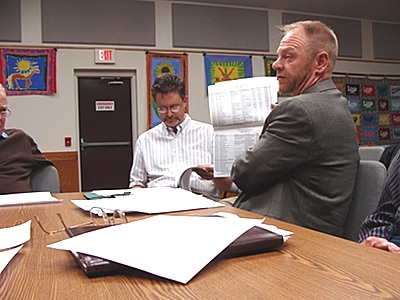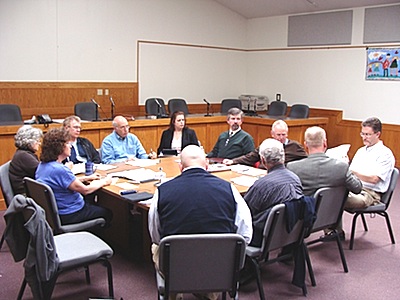- By Dan Veaner
- News
 Print
Print  The Lansing Sewer Committee continued gatherring information on funding for the town sewer project Wednesday. The proposed sewer is now at the phase where the cost to district residents will make or break the project. Environmental Facilities Corporation's (EFC) Terry Deuel met with committee members to explain the process that could bring subsidized funding to the project. Committee member Andy Sciarabba, Lansing Supervisor Kathy Miller, and engineer David Herrick met with EFC officials in a phone conference Monday, and Deuel agreed to attend the Wednesday meeting.
The Lansing Sewer Committee continued gatherring information on funding for the town sewer project Wednesday. The proposed sewer is now at the phase where the cost to district residents will make or break the project. Environmental Facilities Corporation's (EFC) Terry Deuel met with committee members to explain the process that could bring subsidized funding to the project. Committee member Andy Sciarabba, Lansing Supervisor Kathy Miller, and engineer David Herrick met with EFC officials in a phone conference Monday, and Deuel agreed to attend the Wednesday meeting."We went through a lot of the questions we had about how to classify some of our institutions as residential or non-residential," Sciarabba told the committee members. "We got a lot of information from them. This is an opportunity for us to find out what it's all about and have questions answered today."
Sciarabba, Miller, and Herrick went to Albany last month to familiarize EFC's executive staff with the project and begin the process of presenting the project in its best light in the hope of getting a loan with the best possible subsidized interest rate. They are hoping to participate in the Clean Water State Revolving Fund to finance the project.
A larger sewer project failed to even come to the stage where property owners in the proposed district could have voted to form a sewer district because sewer committee members and town officials knew that the estimated $900 per year was too expensive. At that time the NYS Department of Environmental Conservation (DEC) insisted that any sewer project Lansing embarked upon be part of an inter-municipal cooperative that would have required the Town to build a trunk line through the Village of Lansing to get to the Cayuga Heights Sewer treatment Plant. Even with $4.2 million in a DEC grant, approximately $900 per Equivalent Dwelling Unit (EDU), the equivalent of a single-family home, was the best the committee could do at that time.
 EFC's terry Deuel explains a scoring system that will determine Lansing's eligibility for a loan, and possibly for favorable interest rates.
EFC's terry Deuel explains a scoring system that will determine Lansing's eligibility for a loan, and possibly for favorable interest rates.Today the DEC has agreed to allow the town to build its own sewage treatment plant, which is targeted to be located near the Cargill mining facility near Portland Point. With a limited initial sewer district that covers an extended town center area that includes the Lansing Lansing schools, Myers Park, Ladoga Park, the town center area including the town hall campus, the area by Lansing Market and Crossroads Bar & Grill, the state juvenile detention centers, and Kingdom Farm. Most of the delivery system would be a gravity system, with pump stations strategically placed where needed.
After the failure of the last sewer project to come to a vote, the DEC withdrew their grant. About half was applied to the Warren Road sewer project, with the rest reverting to the State at a time when it was dealing with a multi-billion dollar budget crisis.
If that money were available today it wouldn't be worth as much as it was in 2008, but it would go a long way toward making the new project affordable. Sciarabba says that the new project won't be accepted by property owners unless the committee can get that cost down to the five or six hundred dollar range. But even with a favorable EFC loan they will need to pursue grants to bring the annual cost per EDU, which is very close to that of the old project, down.
EFC considers the details of each project and assigns it a score based on a variety of factors that may include environmental concerns, wealth of a community, and percentage of residential EDUs within a proposed district. Over-age septic systems at the Lansing School campus and replacing private sewage treatment facilities licensed with State Pollutant Discharge Elimination System (SPDES) permits with municipal sewer can also help the project get a better score. The juvenile detention facilities on Auburn Road and Cargill mining facility are examples of local facilites with SPDES plants.
"To even qualify for consideration with EFC we have to have a certain score," Miller said. "That's what we're working on. Once we get a score that's good enough to be considered then we move into the next phase, the consideration phase."
The Lansing project has challenges that committee members hope to meet to get a better score. One is to define the initial sewer district in a way that includes more than 50% of residential EDUs which could qualify the project for a loan with lower interest rate.
 Lansing Sewer Committee: (clockwise from left) Clerk Rachel Jacobson, Supervisor Kathy Miller, Mark Booth, Andy Sciarabba, CJ Delvecchio, Councilman Ed LaVigne, Tom Jones, engineer David Herrick, EFC Environmental Project Manager Terry Deuel, Noel Desch, Tompkins County Director of Assessment Jay Franklin
Lansing Sewer Committee: (clockwise from left) Clerk Rachel Jacobson, Supervisor Kathy Miller, Mark Booth, Andy Sciarabba, CJ Delvecchio, Councilman Ed LaVigne, Tom Jones, engineer David Herrick, EFC Environmental Project Manager Terry Deuel, Noel Desch, Tompkins County Director of Assessment Jay FranklinCommittee members are hoping EFC will consider future EDUs that will result from the town center project, specifically senior housing projects proposed by NRP Group at a Planning Board meeting last week. The committee is faced with a chicken and egg conundrum: it needs the new EDUs to bring the cost of sewer down, and the Town needs sewer to make the new project feasible. If the Town can nail down a contract with NRP that insures the units will be constructed contingent on a sewer being completed by a certain date, officials are hoping EFC will include the new units in their scoring calculation.
Deuel said $62,034 is listed as the average town-wide annual income. Sciarabba said that income within the district is probably a lot lower than the $62K figure. If the Town can show that incomes in the district are lower, it may also qualify the project for a lower interest rate in order to make their payments affordable. But proving it will mean conducting a survey of residents because the data is not available by other means. Changes in federal questionnaires for the 2010 census make it harder to gather data needed to make the town's case. County Ascessor Jay Franklin said that he isn't permitted to provide some data the committee needs.
Another hurdle for the project is that the town will be forced to present a worst-case scenario to voters. Only property-owners within a sewer district pay for sewer, and they are the ones who get to vote on whether or not to form a sewer district in the first place. The 'worst case scenario' is the highest annual cost. It can't include grants until they are officially awarded.
As homes and businesses are added to the district, the cost per EDU goes down because there are more property-owners to share that cost (there is a formula for calculating the number of EDUs on vacant lots, but it is much lower than EDUs defined by occupied buildings within the district). But again, these cannot be included in the figures presented to voters, even if there are firm plans to build the units.
Another challenge is explaining to property owners how sewer costs will eventually be less than replacing aging septic systems. While all property owners within a sewer district have to pay, those who are hooked up to the sewer pay more. Property owners with newer septic systems are less likely to vote for sewer, so a grace period is being considered to allow businesses and residents with newer septic systems more time before they are required to hook up to the sewer. The length of the grace period has not yet been set, but it will likely be ten years, the period attached to the earlier sewer project.
Comittee members divvied up followup tasks to try to get up to date data from the school district and the health department on failing septic systems, SPEDES runoff data, etc. They will meet again next Wednesday.
v8i14



